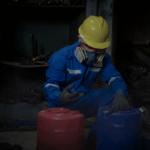Managing Fatigue, the Overlooked Safety Risk of Year-End Workloads
As companies race to meet end-of-year goals, long hours, tight deadlines, and increased workloads can quietly introduce one of the most dangerous hazards in the workplace: fatigue.
The Hidden Cost of Fatigue
Fatigue is more than just feeling tired. It impairs judgment, slows reaction time, and increases the likelihood of mistakes. In high-risk environments like manufacturing, construction, and transportation, these lapses can lead to injuries, property damage, and production delays.
According to the National Safety Council, fatigue contributes to an estimated 13 percent of workplace injuries and costs employers billions annually in lost productivity and workers’ compensation claims.
What Causes Fatigue in Industrial Settings
- Extended Shifts and Overtime: Longer hours reduce recovery time and increase mental fatigue.
- Night Work or Rotating Schedules: Disruptions to circadian rhythm impair alertness and concentration.
- Environmental Stressors: Heat, noise, and poor lighting compound fatigue during long shifts.
- Understaffing or Holiday Deadlines: Fewer people carrying heavier workloads can amplify the risk.
Reducing Fatigue Through Better Management
- Review Shift Schedules
Ensure adequate rest periods between shifts and limit consecutive long-hour days. Administrative controls can make a measurable difference. - Promote Supervisory Awareness
Train supervisors to identify signs of fatigue and empower them to adjust workloads or schedules as needed. - Encourage Open Communication
Employees should feel comfortable reporting fatigue concerns without stigma or penalty. - Integrate Fatigue Into Safety Programs
Include fatigue management in toolbox talks, risk assessments, and pre-task briefings. Treat it like any other hazard, with planning, monitoring, and mitigation.
A Culture of Alertness
Fatigue management starts with leadership commitment. When organizations prioritize rest and awareness, workers stay sharper, safer, and more productive.
At Pearson Safety Solutions, we help companies build safety cultures that account for human factors because even the best systems depend on alert, engaged people.
Protect your team during the busiest season. Are you ready to strengthen your fatigue management approach for 2026? Contact us!


